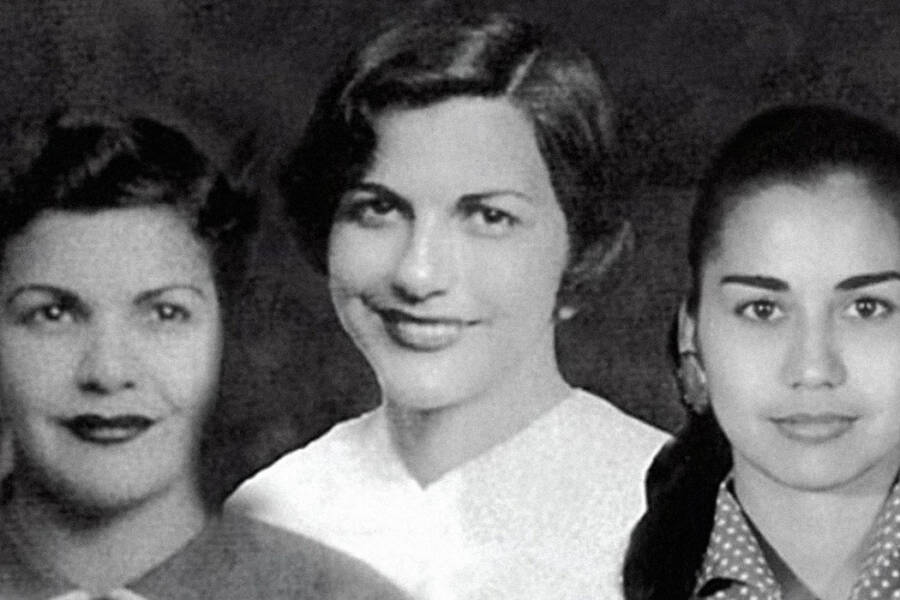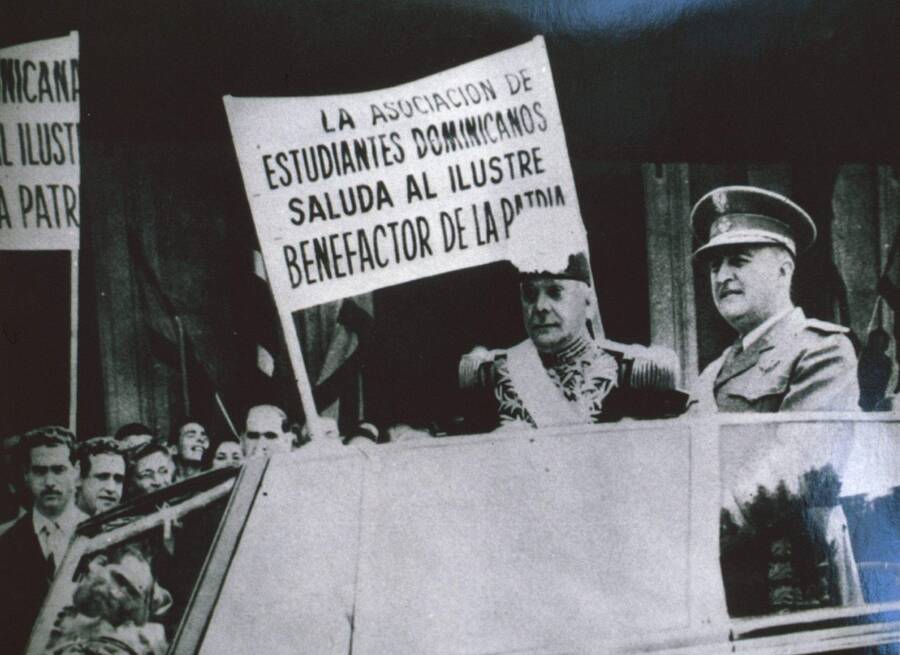Patria, Minerva, and María Teresa Mirabal bravely fought against the dictatorship of Rafael Trujillo until their assassination in 1960. Today, they’re seen as martyrs and icons of revolution.

Barnaby DavidThe Mirabal sisters from left to right: Patria, Minerva, and María Teresa.
Born to a family of farmers in the middle class, Mirabal sisters Patria, Minerva, and María Teresa had fairly comfortable upbringings in the Dominican Republic.
Then, the violent dictator Rafael Trujillo rose to power in 1930, setting off a chain of events that would radicalize the Mirabal sisters and make them leaders of the resistance.
The “Mariposas,” as the sisters were called, got arrested multiple times and repeatedly risked their lives for their movement before they were ultimately assassinated in 1960. But their efforts were not in vain.
This is the story of the Mirabal sisters, the fearless Dominicana activists who helped fuel the revolution that would eventually take down Rafael Trujillo.
The Mirabal Sisters’ Childhood
The Mirabal family worked as farmers in Ojo de Agua, Dominican Republic. The sisters’ parents, Enrique and Maria Mercedes Maribal, were part of the social elite and were able to send their daughters to Catholic boarding schools in the region.
The oldest of the four Mirabal sisters, Patria, was born Feb. 7, 1924. According to The Vintage News, she attended boarding school at age 14 and spent three years there before leaving to marry a farmer named Pedro Gonzalez. They went on to have three children.
The third oldest, Minerva, was born on March 12, 1926. At 12 years old, Minerva attended the same Catholic school as her oldest sister and quickly developed a passion for politics and law. Minerva went on to enroll at the University of Santo Domingo and graduated with a law degree, becoming the first woman to graduate from law school in the Dominican Republic.
The youngest Mirabal sister was María Teresa, born Oct. 15, 1935. She, too, went to Catholic boarding school and later attended the University of Santo Domingo to study mathematics.
These three sisters comprised “Las Mariposas” of the Dominican Republic.
The second oldest sister was Dedé, born in 1925. Unlike her sisters, Dedé did not participate in politics but instead stayed at home to run the household. Later, she would dedicate her life to keeping her sisters’ memory alive.
The Dictatorship Of Rafael Trujillo

Public Domain The Heads of State of Spain and the Dominican Republic, Francisco Franco and Rafael Trujillo, traveling by car.
Rafael Trujillo served as the leader of the Dominican Republic from 1930 until his assassination in 1961.
Prior to assuming the presidency, Trujillo, also known as “El Jefe,” served as Commander of the Dominican National Police starting around 1925, Encyclopaedia Britannica reports. In the years following, Trujillo was named general.
With his appointed power, Trujillo transformed the police force into an army and led a rebel coup against President Horacio Vásquez. By 1930, Trujillo was president of the Dominican Republic.
Under his rule, Trujillo turned the Dominican Republic into a one-party state. History reports that anyone who opposed the party put themselves at risk of being murdered or arrested by the secret police.
According to the Chicago Public Library, Trujillo required all Dominicans to hang a picture of him in their homes and even encouraged parents to teach their children to revere him. Meanwhile, Trujillo’s secret police regularly kidnapped, tortured, raped, and killed potential dissenters. Over the years, tens of thousands of people were killed by Trujillo’s regime.
But the worst moment of the Trujillo dictatorship came on Oct. 2, 1937, when he called for the massacre of Haitians living in the Dominican Republic. An estimated 13,000 to 20,000 Haitian people were murdered as a result of the killing, dubbed the Parsley Massacre, though some estimates say it could be as many as 40,000.
“Trujillo did it because he hated us, because he didn’t want to see Black people in his country. It was in his roots to be racist,” survivor Gilbert Jean told NPR about the attack.
It was exactly this type of brutal oppression that inspired the Mirabal sisters to begin their fight against Trujillo.
The Mirabal Sisters’ Political Beliefs

Women’s Museum of CaliforniaThe Mirabal sisters, dubbed “Las Mariposas” or “The Butterflies,” together.
The Mirabal sisters, apart from Dedé, were all politically active, and although all three women eventually married and had children, it did not prevent them from becoming key players in the underground movement against Trujillo.
Even in their personal lives, the Mirabals made sure to only marry men who shared their political views. According to the documentary Code Name: Butterflies, María Teresa refused to hold hands with the man who would later become her husband until she was sure he wasn’t a Trujillo supporter.
Initially, Minerva became exposed to the new ideas that made her question Trujillo’s regime while studying politics at university. Then, she had a personal experience with Trujillo that ultimately marked her for the rest of her life.
Trujillo was known for making advances on women and punishing those who refused him. While attending a dance, Trujillo became interested in Minerva and aggressively propositioned her. She rejected him, slapping him in the face. According to The Vintage News, upon this rejection, Trujillo asked Minerva,
“What if I send my subjects to conquer you?”
She responded, “And what if I conquer your subjects?”
After this altercation, Trujillo retaliated against Minerva, often sending his men to harass or arrest her. He even ensured that her license to practice law was denied. But in doing all this, he made himself a dangerous enemy.
Las Mariposas’ Fight Against Trujillo’s Rule
Minerva soon became involved in efforts to take Trujillo down, and was shortly joined by María Teresa.
Patria was the last sister to join the resistance after she witnessed a brutal massacre perpetrated by Trujillo’s men on June 14, 1959. Driven by their outrage at this atrocity, the Mirabal sisters helped form an underground opposition group called the Movement of the Fourteenth of June.
As part of the resistance, the Mirabal sisters passed out pamphlets detailing the violence of the Trujillo regime, stockpiled guns and bombs, and spoke out against his rule.
Eventually, their efforts would land Minerva, María Teresa, and all three of the sisters’ husbands in jail. Despite the arrests, the Mariposas continued their struggle against Trujillo.
“Perhaps what we have most near is death, but that idea does not frighten me. We shall continue to fight for that which is just,” María Teresa declared, as reported by The Vintage News.
The Assassination Of The Butterflies Of The Dominican Republic
By 1960, the Organization of American States condemned Trujillo’s regime. This condemnation led to the sisters’ release from prison, but their husbands remained incarcerated in Santo Domingo.
On Nov. 25, 1960, the Mirabal sisters went together to visit their husbands in prison.
After checking in with the men, the three sisters and their driver headed back home in their Jeep, but were abruptly stopped on the side of the road by Trujillo’s men.
Then, the soldiers murdered their driver and pulled the sisters from the car. There, on the road, Trujillo’s men brutally beat and strangled the Mirabal sisters to death. The soldiers then placed all of their bodies inside the Jeep and pushed the vehicle off of a cliff to make it seem like an accident.
But the people of the Dominican Republic weren’t fooled. News of the killings rocked the country, and calls for Trujillo’s downfall rang out louder than ever before.
Only six months after the sisters’ assassination, Trujillo himself was assassinated in Santo Domingo by a group of rebels and former armed forces members.
Many historians believe that the Mirabal sisters helped pave the way for Trujillo’s death. According to historian Bernard Diederich in his book Trujillo: The Death of the Dictator, the deaths of the Mirabal sisters “had greater effect on Dominicans than most of Trujillo’s other crimes.”
The Legacy Of The Mirabal Sisters
Following the deaths of her sisters, Dedé Mirabal became dedicated to keeping their memories alive, launching the Mirabal Sisters Foundation and opening the Mirabal Sisters Museum in their hometown. She carried on their message until she died in 2014.
For decades following the Mirabal sisters’ deaths, Dominicans have revered them as martyrs, and over time, the Mariposas have become an international symbol of resistance and feminism. In 1999, the United Nations General Assembly designated the anniversary of their deaths, the 25th of November, as the International Day for the Elimination of Violence against Women.
Today, the Mirabal sisters’ story stands as an inspiring reminder to stand up for what’s right. As María Teresa fatefully said in a quote published by TIME,
“If they kill me, I’ll reach my arms out from the tomb and I’ll be stronger.”
After reading about the Mirabal sisters, discover the story of Lepa Radić, a teenager who died fighting against Nazi rule in Yugoslavia. Then, uncover the story of Simone Segouin, the 18-year-old who hunted down Nazis with the French Resistance.





